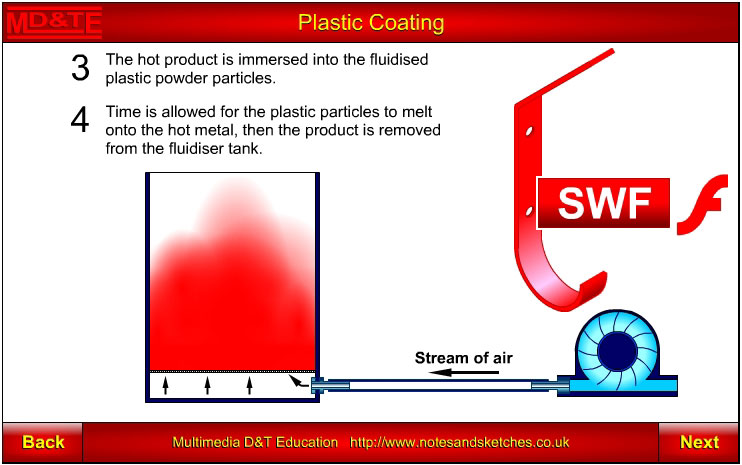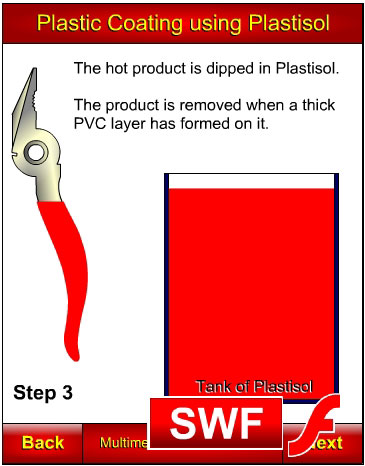 |
|||||
Click on the screenshot above to view the plastic coating animation by Laszlo Lipot |
|||||
|
|||||
IntroductionA plastic coating gives metals a thick, wear resistant finish that excludes water and air from the surface of the metal and so prevents corrosion. Plastic coating is applied mainly by:
Hot dip coating in a fluidised bed of polymer powderMetals that will be plastic coated must be cleaned thoroughly to remove all traces of dirt and grease. Cleaning is usually done using a chemical cleaning and degreasing agent. After cleaning, the metal part is placed in an oven and heated to a temperature that will melt the polymer powder. The metal part should be heated to between 250°C and 400°C, depending on the polymer powder being used. When the metal part is hot enough, it is quickly taken to a fluidising bed that contains the polymer powder. A compressor blows air through a fine gauze into the polymer powder, making the fine polymer particles rise and bubble within the fluidiser tank. The hot metal part is immersed in the fluidised polymer particles and held there until a layer of polymer has melted and adhered to the surface of the hot metal. The metal part is taken out of the fluidiser tank when there is a sufficiently thick covering of melted polymer powder stuck to the metal or when the metal has cooled and no more polymer melts and sticks to it. The plastic coated metal part is then reheated to ensure that the polymer powder has melted completely throughout its thickness. After a few minutes of heating, the metal part is removed from the oven and allowed to cool. The metal part should now have an even covering of shiny plastic, without any pin holes or other defects. If any defects are found, or if the plastic layer is insufficiently thick, the metal part may be reheated and given another coat of polymer particles. Various polymer powders are used for fluidised bed plastic coating including PVC, Nylon and Polyethylene. |
|||||
|
|||||
Spraying polymer powder onto a heated product (Flock spraying)It is not practical to place very large products into a fluidised bed of polymer powder or into a tank of liquid Plastisol. For this reason, very large products are heated and sprayed with polymer powder (flock) to achieve a plastic coating. The process involves cleaning the metal part using chemical cleaning and degreasing agents, then heating the part to a suitable temperature that will melt the flock that will be sprayed onto it. Next, flock is sprayed onto the heated product. Heat from the metal melts the flock and coats the product. Flock will continue to melt and adhere to the metal product as long as the temperature of the metal is above the melting temperature of the flock. The surface of the plastic coating may have partially melted flock stuck to it. To fully melt the flock, the product must be reheated. The process may be repeated several times in order to build up the thickness of the plastic coating. |
|||||
| Click here to view the PDF version of this resource. | 
|
 |
|||
